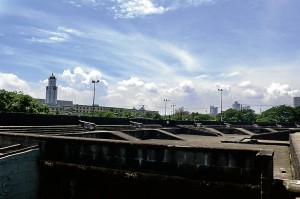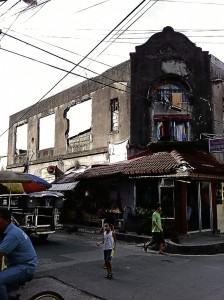
Endangered,” A recent press statement by the Global Heritage Fund said of Intramuros.
The Manila press feasted on the statement.
What does it really mean to be “endangered?” In conservation terms, when a site is described as endangered it is not doomed; it signals that the site needs intensive care to preserve its heritage qualities.
“Endangered” is simply an alert to the local and international community that concentrated conservation effort is needed to prevent the site from falling into total disrepair, a message clearly sent during the international forum on “Global Heritage in the Developing World: Focus Asia” held earlier this month at the Asia Society in New York which the Global Heritage Fund organized.
The list of “endangered” sites released during the forum included, in no particular order or ranking, Intramuros, the fortified former Spanish-colonial capital of the Philippines; Ayutthaya, former Thai capital; Kashgar, one of the last preserved Silk Road cities in China; Mahasthangarh in Bangladesh, among South Asia’s earliest archeological sites; Mes Aynak, an Afghan Buddhist monastery complex on the Silk Road; Myauk-U, the capital of the first Arakenese kingdom in Myanmar; Plain of Jars in Laos, a mysterious megalithic site; the Preah Vihear, a Khmer architectural masterpiece in Cambodia; Rakhigari in India, biggest among the ancient Indus sites; and Taxila, an ancient economic crossroads in Pakistan.
At the well-attended forum, conservation professionals, site managers, speakers and panelists discussed development challenges facing the 10 Asian heritage sites, often with lively involvement of leading experts in conservation, international development, venture philanthropy, technology, travel, academia and media who participated in the event.
Threats, potentials
Discussed were existing threats and specific mitigation proposals suggested to conserve each of the 10 most significant heritage sites in Asia that the forum focused upon. Each site, a global treasure like hundreds of others across Asia and the developing world, remains untapped as a resource for national and community economic development.
Intramuros, among the sites singled out by the Global Heritage Fund, requires assistance for it to take full advantage of its unique heritage qualities as a resource for national and community development.
However, Intramuros exists on various levels, therefore the assistance it needs goes beyond financial. It is a national monument, symbol of the Filipinos’ Spanish-colonial heritage; it is also a tourism and educational destination, and an urban center where people study, live and work.

Intramuros Administration has done admirably. It has restored and rehabilitated Fort Santiago; completely reconstructed the fortifications damaged by World War II; faithfully reproduced early 19th-century colonial architecture at Plaza San Luis; and has enforced building regulations to maintain the period ambiance of Intramuros.
Life inside
Other government agencies have contributed to Intramuros as well. Soon to finish is the reconstruction of the Spanish-colonial building, the Intendencia, which will serve as the offices for the Department of Finance. Soon to start is the reconstruction of the Aduana to be the future National Archives.
Restoration and rebuilding Intramuros as a historic monument, already achieved by the Intramuros Administration, provides the building envelope, or the hardware that is incomplete without the software that gives it life.
Intramuros should live again. Software will make that happen. What would all the reconstructed building be without everyday life happening inside?
Heritage should come alive. Intramuros should reclaim its forgotten significance to the Filipino nation. Visiting the Walled City should be a fun learning experience. A balance should be arrived at among the heritage, tourism, education, community and development aspects of Intramuros.
Students, businessmen and office workers, the handful of permanent residents, and the informal residents who form the fragmented Intramuros community are yet to realize the significance of Intramuros and to fully participate in its renaissance which will bring them not only economic benefit but pride of place.
Intramuros plan
The Intramuros renaissance has begun. The Intramuros Development Plan, supported by the Department of Tourism, has pointed out interrelationships among parallel activities that must take place: tourism, heritage conservation, education, community and economic development.
What the development plan takes is a holistic view of Intramuros, developing both hardware and software together. For hardware, it looks in detail at how to rebuild Intramuros to achieve maximum benefit for its landowners or to attract the appropriate commercial development while rigorously maintaining the district’s special heritage qualities.
For software, it establishes community participation in tourism, heritage and economic programs, as well as educational and public-awareness programs and special events.
For informal-settler community development, Intramuros Administration has partnered with Gawad Kalinga.
Global Heritage Fund, headquartered in Palo Alto, California, is looking forward to participating in the Intramuros renaissance, to be part of the concerted effort to bring Intramuros back to life through assisting in the planning process, streetscape development, community programs and partnering with Gawad Kalinga for community development.
With funds raised from international donors, Global Heritage Fund provides counterpart funding to the existing budget allocated by the Department of Tourism, Intramuros Administration, Department of Public Works, and Public-Private Partnership projects, to achieve sustainable conservation of Intramuros as a vibrant urban-heritage area.
When working with heritage, there is always a sense of urgency, because once heritage vanishes, it is gone forever. With the element of urgency always above the heritage professional’s head, all sites are seen as “endangered.”
Comments and feedback are welcome at pride.place@gmail.com.

